LONDON: An Egyptian-British mother on hunger strike in protest against the detention of her activist son in Cairo has been given a glucose drip after being hospitalized in London, a campaign group said on Friday.
Laila Soueif, 68, has been on hunger strike for 152 days and was admitted to London’s St. Thomas’s Hospital late on Monday due to “dangerously new lows” in her blood sugar and sodium levels, as well as her blood pressure.
She had previously turned down artificial glucose, despite being warned there was an “immediate risk to life,” but agreed at the request of her daughters Sanaa and Mona to take one dose “in an effort to extend her life,” campaign group Free Alaa said in a press release.
Soueif has lived on only coffee, tea and rehydration sachets since September 29, 2024, the date that marked five years in detention for her son Alaa Abdel Fattah.
Fattah, 43, a pro-democracy and rights campaigner, was arrested by Egyptian authorities in September 2019 and later given a five-year sentence for “spreading false news.”
His family criticized his trial as a “farce” and has demanded he be released having completed his sentence.
Soueif started the drip on Thursday and the dose was given to her over the course of 12 hours “due to the dangers of the intervention at this stage in her hunger strike,” said the campaign group.
“Doctors at the hospital have stressed that this is a temporary intervention, that they cannot guarantee it will extend Laila’s life, and that if it does it will be for a limited time, possibly only a few hours, and if lucky a few days,” they added.
Soueif has lost almost 30 kilograms (66 pounds) since starting her hunger strike, which she has vowed to continue until her son is released.
For weeks, Soueif braved London’s bitter cold to demonstrate outside Prime Minister Keir Starmer’s Downing Street office each working day since the date she says her son should have been released.
Sanaa Seif called on Starmer to take urgent action.
“When we met Keir Starmer he asked us for more time and promised that he would do all he could to free my brother,” she said.
“I don’t think we’ll be able to convince mum to do this again. So we desperately urge the prime minister to use this time well,” she added.
Hunger-striking mother of jailed UK-Egyptian activist on glucose drip
https://arab.news/yznym
Hunger-striking mother of jailed UK-Egyptian activist on glucose drip

- Laila Soueif, 68, has been on hunger strike for 152 days and was admitted to London’s St. Thomas’s Hospital late on Monday
- She had previously turned down artificial glucose, despite being warned there was an “immediate risk to life“
Amroti ‘Water’ Mosque: Century-old symbol of faith and resistance in southern Pakistan

- Mosque was built around 1890 under guidance of Syed Taj Mahmood Shah Amroti, first translator of Qur’an into Sindhi language
- Mosque’s location became problem when British wanted to built Sukkur Barrage but resistance by Amroti and followers forced retreat
SHIKARPUR, Sindh: Standing on seven pillars in the middle of the Kirthar Canal, a unique mosque in Pakistan’s southern Shikarpur district is more than just a place of worship — it is a symbol of defiance and resistance against British colonial rule.
With its whitewashed walls rising above the flowing waters, the Amroti Mosque’s architecture is as unique as its story.
The mosque was first constructed from mud, wood and palm tree trunks on a mound around 1890 under the guidance of scholar and educationalist Syed Taj Mahmood Shah Amroti, who was the first to translate the Holy Qur’an into the Sindhi landguage and provide detailed explanations of its teachings. For years, the mosque served as a place of workshop for the residents of Junejo village in Shikarpur until its location became an issue when the British colonial rulers of India decided to build the Sukkur Barrage and its canals, ordering the demolition of the masjid.
Historical accounts say Amroti sent over 20 letters to authorities asking to change the canal’s route but received no response and the British eventually issued a warrant for his arrest.
“In 1922, the British government started the Kirthar Canal project to irrigate uncultivated lands of Sindh and Balochistan [provinces],” Sayed Rushdullah Shah Amroti, the administrator of Amroti Mosque and the great grandson of Amroti, told Arab News.
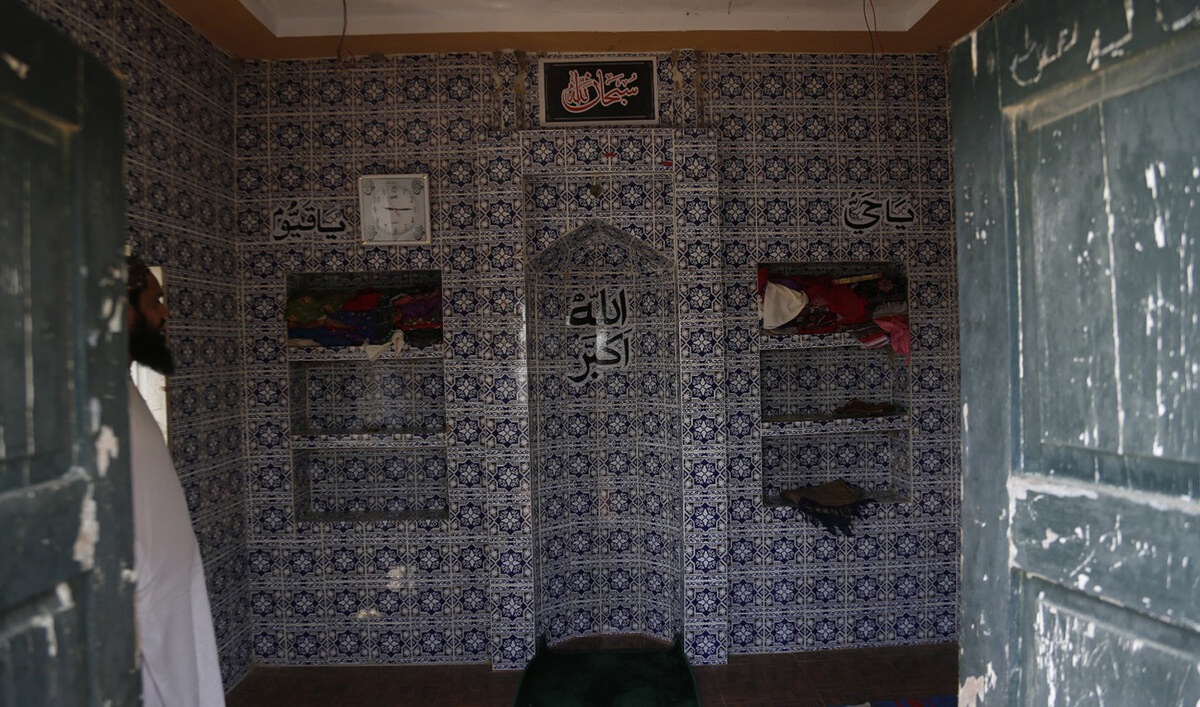
“When Hazrat Amroti came to know that the British government wanted to demolish the mosque, he decided to camp here and offered stiff resistance to British authorities.”
When British officials arrived with machines to demolish the mosque, local villagers joined Amroti in a massive protest. In the end, the British agreed not to destroy the mosque and instead promised to strengthen its structure so that both the mosque and the canal could remain.
“The impact of the resistance was that the British government was forced to kneel down,” Sayed said. “They left the mosque as it was and made the canal around its four sides.”
The mosque in its present shape was subsequently built, serving as a reminder of the importance of both faith and rebellion as it stood amid the waters of the Kirthar Canal, which originates from the Indus River at Sukkur Barrage and became operational in 1932 as a vital watercourse for Balochistan, particularly districts like Jafarabad and Naseerabad.

“STRANGE SPIRITUAL STATE”
In the past, residents would use boats to reach Amroti Mosque for prayers but after independence from British rule in 1947 and the creation of the two separate nations of Pakistan and India, the government rebuilt a proper structure for the mosque, constructed a bridge for easier access and ensured that water continued to flow beneath it.
Though the small mosque only allows 10-12 people to pray at a time, it holds great cultural and spiritual value for the people of the area.
“We are very proud of the religious and Islamic achievements of our ancestors, and wherever we go in the world, the respect we receive because of our connection to Amroti Sharif is largely due to the role of this mosque,” Rushdullah said.
Nasim Bukhari, a local writer, described the mosque as a “great symbol of resistance in history.”
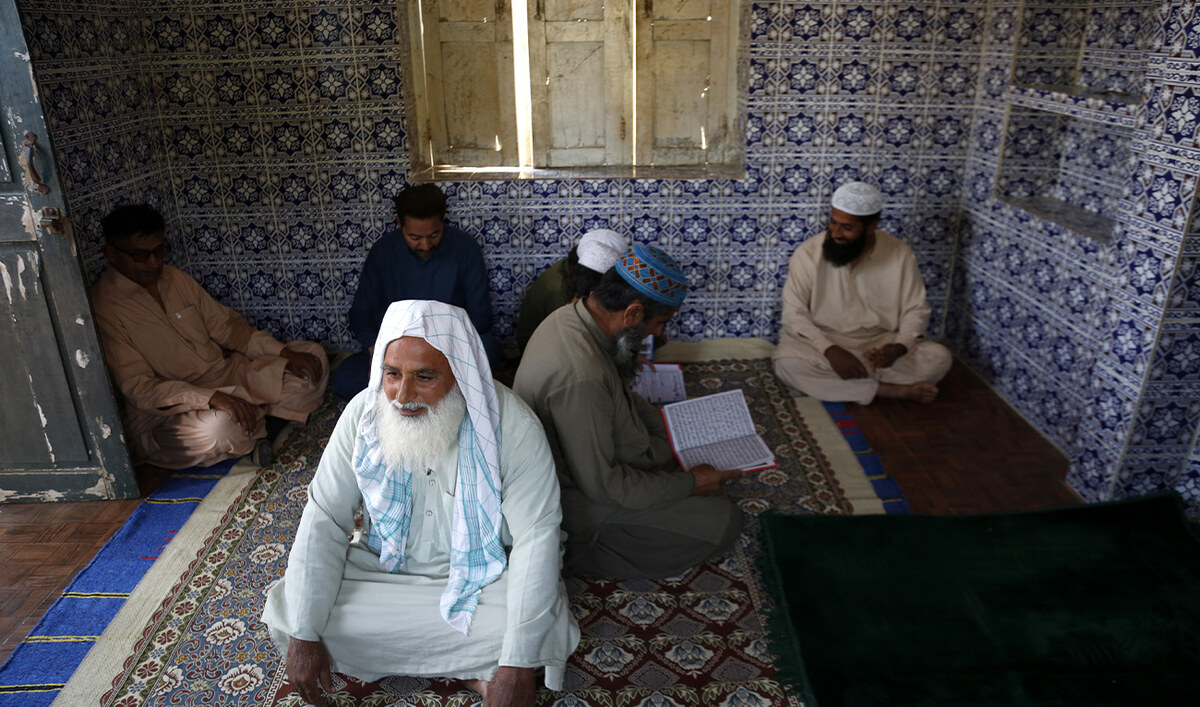
“And this has been the history of Sindh, that we have never accepted defeat. Even if we had to face defeat, we would die with our names still alive. We never ran away,” he said.
Amroti’s struggle was part of a larger resistance movement in Sindh, according to Bukhari.
“Syed Taj Mahmood Amroti fought against the British in his time and became a symbol of resistance. The people of that time, unarmed, fought with perseverance,” the author said, highlighting Amroti as an inspiration for others. One of his disciples, Syed Salah Aajiz Memon, later became the first Sindhi and Muslim figure against whom the British filed a case for rebellion.
“The name and deeds of our leader, Syed Taj Mahmood Amroti, have had their impact, but the resistance movement led by his followers and disciples also carries a remarkable legacy,” Bukhari said.

To date, the mosque continues to serve as a place of deep spirituality and worshippers describe a “profound sense of peace” at the place, especially when the water runs high and the mosque appears to be floating in the canal.
“While praying here, a strange spiritual state occurs,” Maulana Shahnawaz Baloch, the prayer leader at the mosque, told Arab News.
“At this time, the water level is low, yet there is still a spiritual atmosphere. When the water level is higher due to the season, a completely different spiritual experience takes place.”
Energy technologies under development more promising than ever before: IEA

RIYADH: The range of new energy technologies under development globally is broader and appears more promising than ever before, according to a prominent think tank.
In its latest report, the International Energy Agency said that the modern energy technology landscape is highly dynamic, with both emerging and established economies contributing to the growth of innovation in the sector.
The analysis from the IEA comes at a time when countries including Saudi Arabia are actively pursuing advanced technology in the sector, as the Kingdom is trying to diversify its energy mix through renewables and nuclear power.
“Innovation is the lifeblood of the energy sector, particularly in today’s fast-moving times with the global energy mix shifting and major trends such as electrification having far-reaching effects,” said Fatih Birol, executive director of the IEA.
He added: “A wide range of technologies now appears to be coming close to market, offering hope for improvements in energy security, affordability and sustainability over the long term.”
The energy agency further said that the global energy innovation landscape is at a pivotal moment amid signs of slowing momentum in financing and shifting priorities.
“We require investment, both public and private, to scale up innovative solutions. The payback may not always be quick, but it will be lasting,” said Birol.
R&D in energy innovation
According to the IEA, energy innovation has delivered major economic and security benefits worldwide.
Public research and development investments in response to energy crises in the 1970s, reaching 0.1 percent of the gross domestic product, drove the expansion of nuclear power and reduced many countries’ reliance on imported fuels.
Nuclear is set to form a key part of Saudi Arabia’s energy mix, and in January the Kingdom’s Energy Minister Prince Abdulaziz bin Salman also said that the nation is planning to begin enriching and selling uranium.
Launched in 2017, Saudi Arabia’s National Atomic Energy Project is a cornerstone of the Kingdom’s strategy to diversify its energy sources and reduce its dependence on fossil fuels.
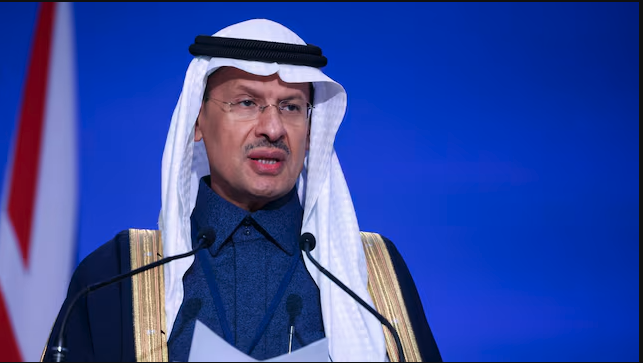
An additional report by the IEA in January projected that annual investments in the nuclear energy development sector would need to double to $120 billion by the end of this decade to meet the rising demand for infrastructure development.
The initiative aims to integrate nuclear power into the national energy mix, enhancing sustainability and fulfilling international commitments.
In its latest report, the energy agency added that energy R&D spending has risen at around 6 percent per year in real terms, with direct government funding across the world up again in 2024, above the $50 billion of the previous year — although the rate of increase has slowed.
“Initial indications of spending in 2024 in the United States and Canada suggest flatter year-on-year growth, balanced by larger increases in Japan and Norway,” said the IEA.
Regarding other major innovative developments, the IEA said that technological advancements in batteries and electric vehicles have lowered oil import needs in China, while shale technology innovation transformed the US from an energy importer to a net exporter.
“The impacts of energy technology innovation are also visible at the level of trade balances. The implementation of horizontal drilling and hydraulic fracturing enabled the US to shift from importing 46 percent of its oil and natural gas needs in 2000 to exporting the equivalent of 10 percent of its demand today,” said the report.
It added: “Innovation in batteries, electric vehicles and their manufacturing enabled China’s oil imports to be 8 percent lower in 2024 than if these EVs had been conventional cars.”
Geographical shift in energy innovation
According to the report, the global landscape of energy innovation is currently witnessing a rapid shift, with nations like China becoming the largest single country for energy patenting in 2021, overtaking Japan and the US.
The IEA added that more than 95 percent of China’s energy patenting in 2022 was in low-emissions technology areas.
Globally, between 2000 and 2022, low-emissions energy patenting was four and a half times that for fossil energy.
The analysis highlighted that more innovation efforts globally are directed toward small-scale and modular energy technologies such as batteries and electrolyzer.
Around half of China’s energy patenting and 90 percent of its venture capital funding is directed to mass-manufactured and modular low-emissions technologies. Innovation in these areas has helped underpin the Asian nation’s lead in several energy technology supply chains.
In Europe, around 50 percent of energy patenting is directed toward smaller-scale low-emissions technologies.
The IEA added that the continent is also active in large engineering projects that generally have more uncertain impacts on long-term competitiveness.
The analysis highlighted that energy inventions in the US are equally spread across fossil fuel as well as large- and smaller-scale low-emissions technologies.
VC funding landscape
The IEA revealed that VC funding for energy technologies surged more than sixfold from 2015 to 2022, reaching levels equivalent to all public energy R&D combined, helping 1,800 startups obtain private capital.
Some $230 billion has been injected into energy startups since 2015, and expectations for this market continue to grow.
“Even if only a fraction of these firms succeed, they could have a significant impact on global energy systems by the 2030s. However, this investment trend reversed in 2023 and 2024, with VC funding declining by more than 20 percent amid tighter financial conditions,” said the IEA.
It added: “The only sector to see growth in VC funding during this period was artificial intelligence, which offers potential to accelerate energy innovation but may also draw capital away from the energy sector.”
The report further said that the primary factor that resulted in the decline of VC funding was inflation, but other elements, like uncertainties about political commitments to climate policies, have also contributed to this trend.
Looking ahead to future funding trends, the IEA noted that early-stage investments in energy storage and batteries remain strong. Additionally, in 2024, there was a noticeable increase in funding for startups focused on technologies related to nuclear energy, synthetic fuels, and carbon capture, utilization, and storage.
In March, energy giant Saudi Aramco launched a pilot direct air capture unit capable of removing 12 tonnes of carbon dioxide annually from the atmosphere.
Aramco said that the facility, developed in collaboration with Siemens Energy is the Kingdom’s first carbon dioxide direct air capture unit.
Affirming its commitment to a sustainable future, Saudi Arabia is also building the world’s largest carbon capture hub on the east coast of the Kingdom in Jubail.
The project is a joint initiative of Saudi Aramco and the Kingdom’s Ministry of Energy and will have a storage capacity of up to 9 million tonnes of carbon dioxide a year by 2027.
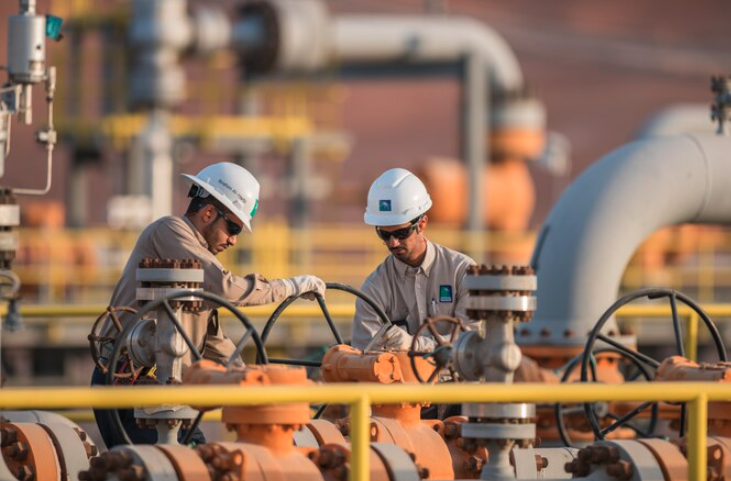
Future outlook
The IEA said that it tracked 580 demonstration projects that are currently aiming to gather essential operational experience by 2030.
The report revealed that $60 billion in public and private financing has already been allocated to these projects in areas such as hydrogen-based fuel production, advanced nuclear designs, floating offshore wind, and CCUS.
“These projects are critical for commercialising emerging technologies but face delays due to inflation and policy uncertainty. Most projects have still not reached final investment decision and 95 percent of demonstration funding is concentrated in North America, Europe and China,” said the report.
It concluded: “At a time of shifting government priorities, coordinated action can nonetheless ensure that a global portfolio of projects bridge the ‘valley of death’ for key technologies to meet climate goals.”
In Pakistan’s Shikarpur, an arms dealer by trade and storyteller at heart

- Agha Sanaullah Khan, 76, has sold weapons since 1090s at Pathan Armory in historic Shikarpur city
- He has authored four Sindhi language travelogues and collection of short stories called ‘Ghalti’, or ‘Mistake’
SHIKARPUR, Sindh: Agha Sanaullah Khan, a 76-year-old arms dealer, sat last month in front of piles of books, with assault rifles, pistols and other ammunition and weapons’ accessories stacked up around them at his shop in the southern Pakistani city of Shikarpur.
Is this a bookstore or an arms dealership?
Welcome to Pathan Armory near Lakhi Dar, one of the seven gates of the historic Shikarpur city, where Khan has been selling weapons for over three decades.
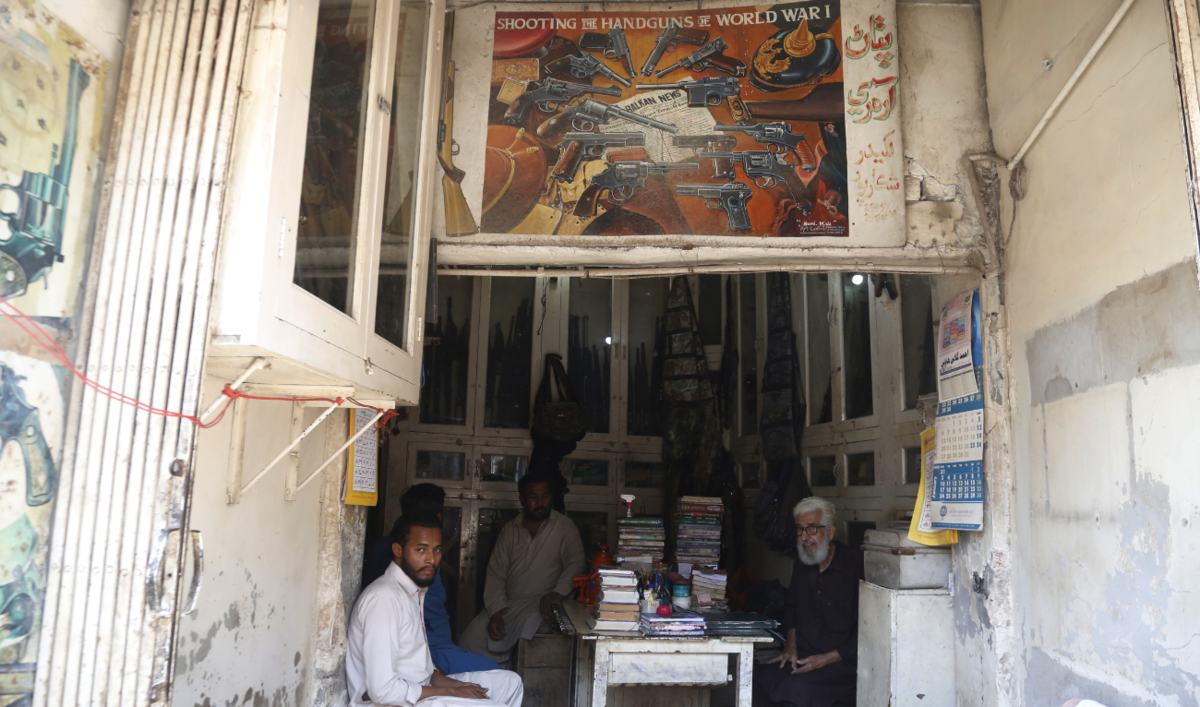
But his true passion lies somewhere else: in writing short stories and travelogues.
The septuagenarian, who has authored four Sindhi language travelogues, and a collection of short stories called ‘Ghalti’, or ‘Mistake,’ says customers who visit his armory are often surprised when they find him pouring over books.
“They come and say, ‘Weapons and books both?’,” Khan said, as he counted change for a customer. “What can I do? Whenever I get free, I read. One should read. Not just reading, I also write here, sir. I sit here and write. This is my nature.”
“Weapons are my business, my livelihood, and I earn from it. I support myself with it,” he explained. “Books are my passion.”
“PASSION FOR TRAVEL”
Khan, whose father was a bureaucrat, set up his armory in the early 1990s in Shikarpur where he lives with his wife while his children are settled in the United states.
The city, which from the 17th to 19th centuries used to be a vital trade hub connecting Central Asia and the Indian Sub-continent, is now plagued by a major crime problem, with several dacoit gangs operating in riverine areas of the district.
Nasir Aftab, Deputy Inspector General of Police (DIGP) Larkana Range, told Arab News the security situation in Shikarpur had improved due to ongoing armed operations against dacoits.
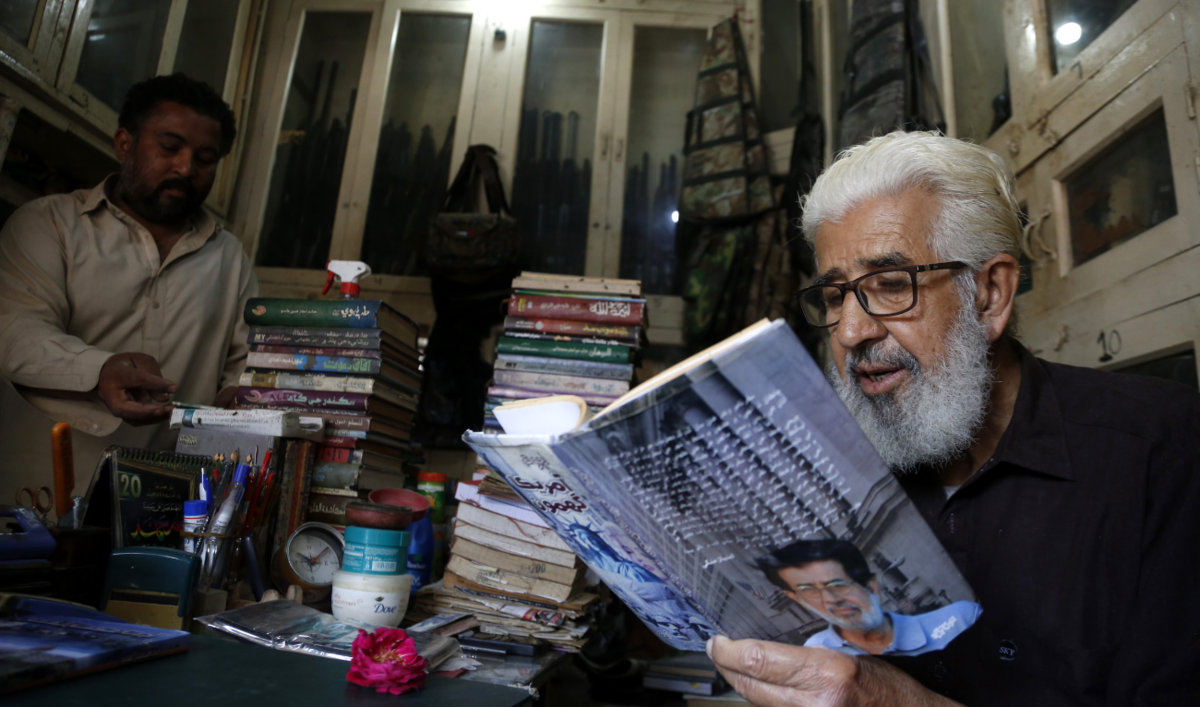
“The operation has weakened the organized criminal network, leading to a drastic improvement in security in the region,” Aftab said. “Public confidence has been restored, and the dacoits are finding it difficult to regroup. With continued law enforcement efforts, lasting peace and security in Shikarpur, Kashmore, and surrounding areas is becoming a reality.”
But for Khan, weapons and pistols were “a necessity now.”
“The law-and-order situation here is such that people are forced to keep guns. And it is allowed by the government, I have the license.”
The arms dealer’s heart, however, lies in storytelling and his passion for travel writing is inspired by a love for tourism.
In his books, he has documented his journeys from the bustling streets of India and the serene landscapes of Nepal to the vibrant markets of Thailand and sprawling cities of the United States.
“When I was born, I had a passion for tourism. When I became wise, I thought I should travel,” he said. “I came into the [arms] business but touring remained stuck in my mind.”
The septuagenarian says his travels to India with friends, which he has written about in his first travelogue, were particularly impactful, as he was able to reconnect with migrants from Shikarpur and experience their hospitality and shared history.
“I met with someone who had migrated from here, Guman Punjabi from Shikarpur. He served me greatly. I met many other migrants and they treated me well,” Khan recalled.
His fascination with America, where his two sons and two daughters live, has led him to write two travelogues while a third one is in the works.
“You can say that I have traveled all over the country, New York, Washington and all major cities of Florida state,” he said, adding that he considered America his second home, but chose life in his hometown of Shikarpur over procuring an American nationality.
Khan, who wants to inculcate a love for reading and writing in others, recently donated nearly 4,000 books to a local library on a friend’s request.
He now wishes to leave behind a legacy that is rooted in his passion for words.
“At present, people know me as an arms dealer,” said Khan as he polished an assault rifle, “but I want that a time comes when people know me more as a travelogue writer.”
GCC’s digital push nears global standards but gaps remain: IMF report

RIYADH: Economies across the Gulf Cooperation Council region are closing the gap with advanced nations when it comes to digital transformation, according to a new International Monetary Fund report.
The study found that the region has rapidly advanced in digital infrastructure and government services since the pandemic but still faces challenges in financial inclusion, corporate digital adoption, and workforce readiness for artificial intelligence.
The findings come as Gulf states accelerate efforts to diversify their oil-dependent economies through technology-driven growth. Saudi Arabia has launched multi-billion-dollar initiatives such as NEOM, Dubai has pushed forward the Digital Silk Road, while Bahrain and Qatar are emerging as fintech hubs.
“Digitalization is transforming the global economic and financial landscape, with the potential to boost productivity and promote diversification in the Gulf Cooperation Council,” stated the report.
“The COVID-19 pandemic has significantly accelerated the digitalization agenda globally, creating new opportunities for the digital economy as an increased number of activities have shifted online,” it added.
The IMF report highlighted that the GCC’s digital acceleration has been particularly notable in public sector services and connectivity. The region’s “GovTech Maturity Index,” which measures digital government transformation, now rivals or exceeds the average of advanced economies.
Saudi Arabia and the UAE lead the region, with their GTMI scores ranking above the 95th percentile globally.
“Most GCC countries have a higher GTMI than the AE (advanced economy) average in 2022, with substantial progress made in every GCC country since the onset of the pandemic,” the report said.
Bahrain, Kuwait, and Saudi Arabia saw particularly sharp improvements, driven by initiatives such as Bahrain’s Tawasul platform for citizen engagement and Saudi Arabia’s Vision 2030 digital economy push.
The report noted that progress has been uneven, with Kuwait lagging in digital citizen engagement and core government systems, while Oman has room for improvement in public service delivery.
“Kuwait, for instance, trails behind its regional counterparts in critical areas, such as digital citizen engagement and the robustness of core government systems,” the IMF report noted.
Fintech growth and financial inclusion gaps
The financial sector has also seen rapid digitalization, particularly in fintech.
Saudi Arabia and the UAE dominate regional investment in this area, with Saudi fintech funding deals surging 80-fold between 2019 and 2022.
Regulatory sandboxes, first introduced in Bahrain, have spread across the GCC, fostering innovation in digital banking and payments.
Despite these advances, the IMF noted that financial inclusion remains a challenge. While access to bank accounts and digital payments has improved, the GCC still lags behind advanced economies.
The report explained that digitalization is strongly correlated with financial inclusion, particularly in emerging markets. A one-unit increase in the IMF’s EDAI — a composite measure of digital progress — is associated with a 0.76 percentage point rise in financial inclusion in emerging markets.
Bahrain and Saudi Arabia stand out as having the highest potential gains from further digitalization. The estimated coefficients of the interaction term for both the countries are positive and significant, indicating a larger-than-EM average effect of digitalization on financial inclusion, the report stated.
Corporate sector and AI
The corporate sector’s digital adoption varies widely across the GCC. While the region boasts world-class digital infrastructure, local production of digital goods and services remains limited.
The report highlighted that Saudi Arabia’s share of inputs from digital industries is significantly lower than in countries at the forefront of digitalization.
Companies in digitally intensive industries, however, have shown greater resilience during economic downturns. “Firms in industries with high intensity of digital inputs suffer smaller revenue losses, and so do firms in digital-intensive industries,” the report added.
Artificial intelligence adoption is rising, with 62 percent of respondents in a McKinsey survey reporting AI use in at least one business function. The UAE and Saudi Arabia are regional leaders in AI preparedness, but gaps persist in digital innovation and regulations.
“The GCC is better prepared than an average emerging market in embracing AI, but gaps remain relative to advanced economies,” the IMF report stated.
Policy priorities: skills, regulation, and inclusivity
The report identified several key areas where the GCC needs to concentrate its efforts to maintain and build upon its digital progress.
One major focus should be on enhancing digital skills, as the region currently trails behind advanced economies in both basic digital literacy and more advanced ICT capabilities.
Implementing comprehensive programs to upskill workers, with particular emphasis on emerging fields like artificial intelligence and cybersecurity, will be crucial for future growth.
Another critical area is the strengthening of fintech regulations. While regulatory sandboxes have successfully encouraged innovation in the financial technology sector, the GCC now requires more comprehensive regulatory frameworks to ensure long-term stability and proper consumer protections as these digital financial services expand.
The report also highlighted the importance of boosting digital adoption among corporations, especially small and medium-sized enterprises. Wider integration of digital tools across businesses could significantly improve overall productivity and make companies more resilient to economic fluctuations.
Finally, as automation and AI continue transforming the job market, the IMF findings noted that GCC will need to proactively address potential labor market disruptions. This includes developing robust social safety nets and creating effective retraining programs to help workers transition into new roles, minimizing the negative impacts of technological displacement on the workforce.
The IMF emphasized that cybersecurity and data protection reforms are also key to maintaining trust in digital ecosystems.
A regional leader with room to grow
The IMF report’s findings underscore that while the GCC’s digital transformation has been impressive, the journey is far from over. With targeted policies, the region can solidify its position as a global digital hub while ensuring that the benefits of technology are widely shared.
“Decisive implementation of the GCC countries’ comprehensive reform agendas — with a special focus on bridging the digital divide and ensuring labor market inclusiveness — will support their efforts to further digitalization,” the report said.
Far-right Israeli minister visits Jerusalem’s Al-Aqsa Mosque compound: spokesperson

JERUSALEM: Israel’s far-right National Security Minister Itamar Ben Gvir visited the Al-Aqsa Mosque compound in Jerusalem’s Old City on Wednesday, his spokesperson said.
The firebrand politician was visiting the disputed site, which is sacred to Jews and Muslims, in occupied east Jerusalem after returning to the Israeli government last month following the resumption of the war in Gaza.




















